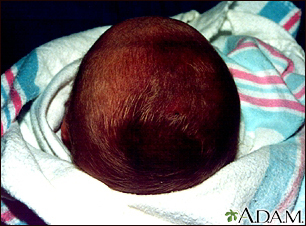Caput succedaneum
Definition
Caput succedaneum is swelling of the scalp in a newborn. It is most often brought on by pressure from the uterus or vaginal wall during a head-first (vertex) delivery.
Alternative Names
Caput
Causes
A caput succedaneum is more likely to form during a long or hard delivery. It is more common after the membranes have broken. This is because the fluid in the amniotic sac is no longer providing a cushion for the baby's head. Vacuum extraction done during a difficult birth can also increase the chances of a caput succedaneum.

A caput succedaneum may be detected by prenatal ultrasound, even before labor or delivery begins. It has been found as early as 31 weeks of pregnancy. Very often, this is due to an early rupture of the membranes or too little amniotic fluid. It is less likely that a caput will form if the membranes stay intact.
Symptoms
Symptoms may include:
- Soft, puffy swelling on the scalp of a newborn infant
- Possible bruising or color change on the scalp swelling area
- Swelling that may extend to both sides of the scalp
- Swelling that is most often seen on the portion of the head which presented first
Exams and Tests
The health care provider will look at the swelling to confirm that it is a caput succedaneum. No other testing is needed.
Treatment
No treatment is needed. The problem most often goes away on its own within a few days.
Outlook (Prognosis)
Complete recovery can be expected. The scalp will go back to a normal shape.
Possible Complications
Complications may include a yellow color to the skin (jaundice) if bruising is involved.
When to Contact a Medical Professional
Most of the time, the problem is noticed right after birth. You do not need to call your provider unless you have other questions.
Gallery

References
Balest AL, Riley MM, Bogen DL. Neonatology. In: Zitelli BJ, McIntire SC, Nowalk AJ, eds. Zitelli and Davis' Atlas of Pediatric Physical Diagnosis. 7th ed. Philadelphia, PA: Elsevier; 2018:chap 2.
Prazad PA, Rajpal MN, Mangurten HH, Puppala BI. Birth injuries. In: Martin RJ, Fanaroff AA, Walsh MC, eds. Fanaroff and Martin's Neonatal-Perinatal Medicine. 11th ed. Philadelphia, PA: Elsevier; 2020:chap 29.